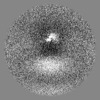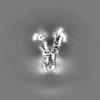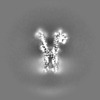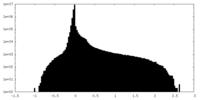+ Open data
Open data
- Basic information
Basic information
| Entry |  | |||||||||
|---|---|---|---|---|---|---|---|---|---|---|
| Title | Cryo-EM structure of human MRS2 with Mg2+ | |||||||||
 Map data Map data | ||||||||||
 Sample Sample |
| |||||||||
 Keywords Keywords | mitochondria / pentamer / cation channel / METAL TRANSPORT | |||||||||
| Function / homology |  Function and homology information Function and homology informationmitochondrial magnesium ion transmembrane transport / Miscellaneous transport and binding events / magnesium ion transmembrane transporter activity / lactate metabolic process / electron transport chain / transmembrane transport / periplasmic space / electron transfer activity / mitochondrial inner membrane / iron ion binding ...mitochondrial magnesium ion transmembrane transport / Miscellaneous transport and binding events / magnesium ion transmembrane transporter activity / lactate metabolic process / electron transport chain / transmembrane transport / periplasmic space / electron transfer activity / mitochondrial inner membrane / iron ion binding / heme binding / mitochondrion Similarity search - Function | |||||||||
| Biological species |  Homo sapiens (human) / Homo sapiens (human) /  | |||||||||
| Method | single particle reconstruction / cryo EM / Resolution: 2.92 Å | |||||||||
 Authors Authors | He Z / Mount JW / Zhang J / Yuan P | |||||||||
| Funding support |  United States, 1 items United States, 1 items
| |||||||||
 Citation Citation |  Journal: Nat Struct Mol Biol / Year: 2025 Journal: Nat Struct Mol Biol / Year: 2025Title: Structure and function of the human mitochondrial MRS2 channel. Authors: Zhihui He / Yung-Chi Tu / Chen-Wei Tsai / Jonathan Mount / Jingying Zhang / Ming-Feng Tsai / Peng Yuan /  Abstract: The human mitochondrial RNA splicing 2 protein (MRS2) has been implicated in Mg transport across mitochondrial inner membranes, thus having an important role in Mg homeostasis critical for ...The human mitochondrial RNA splicing 2 protein (MRS2) has been implicated in Mg transport across mitochondrial inner membranes, thus having an important role in Mg homeostasis critical for mitochondrial integrity and function. However, the molecular mechanisms underlying its fundamental channel properties such as ion selectivity and regulation remain unclear. Here we present a structural and functional investigation of MRS2. Cryo-electron microscopy structures in various ionic conditions reveal a pentameric channel architecture and the molecular basis of ion permeation and potential regulation mechanisms. Electrophysiological analyses demonstrate that MRS2 is a Ca-regulated, nonselective channel permeable to Mg, Ca, Na and K, which contrasts with its prokaryotic ortholog, CorA, operating as a Mg-gated Mg channel. Moreover, a conserved arginine ring within the pore of MRS2 functions to restrict cation movements, thus preventing the channel from collapsing the proton motive force that drives mitochondrial adenosine triphosphate synthesis. Together, our results provide a molecular framework for further understanding MRS2 in mitochondrial function and disease. | |||||||||
| History |
|
- Structure visualization
Structure visualization
| Supplemental images |
|---|
- Downloads & links
Downloads & links
-EMDB archive
| Map data |  emd_41587.map.gz emd_41587.map.gz | 27.4 MB |  EMDB map data format EMDB map data format | |
|---|---|---|---|---|
| Header (meta data) |  emd-41587-v30.xml emd-41587-v30.xml emd-41587.xml emd-41587.xml | 20.5 KB 20.5 KB | Display Display |  EMDB header EMDB header |
| Images |  emd_41587.png emd_41587.png | 99.6 KB | ||
| Filedesc metadata |  emd-41587.cif.gz emd-41587.cif.gz | 6.3 KB | ||
| Others |  emd_41587_additional_1.map.gz emd_41587_additional_1.map.gz emd_41587_half_map_1.map.gz emd_41587_half_map_1.map.gz emd_41587_half_map_2.map.gz emd_41587_half_map_2.map.gz | 26.3 MB 48.4 MB 48.4 MB | ||
| Archive directory |  http://ftp.pdbj.org/pub/emdb/structures/EMD-41587 http://ftp.pdbj.org/pub/emdb/structures/EMD-41587 ftp://ftp.pdbj.org/pub/emdb/structures/EMD-41587 ftp://ftp.pdbj.org/pub/emdb/structures/EMD-41587 | HTTPS FTP |
-Validation report
| Summary document |  emd_41587_validation.pdf.gz emd_41587_validation.pdf.gz | 667.1 KB | Display |  EMDB validaton report EMDB validaton report |
|---|---|---|---|---|
| Full document |  emd_41587_full_validation.pdf.gz emd_41587_full_validation.pdf.gz | 666.7 KB | Display | |
| Data in XML |  emd_41587_validation.xml.gz emd_41587_validation.xml.gz | 12.1 KB | Display | |
| Data in CIF |  emd_41587_validation.cif.gz emd_41587_validation.cif.gz | 14.1 KB | Display | |
| Arichive directory |  https://ftp.pdbj.org/pub/emdb/validation_reports/EMD-41587 https://ftp.pdbj.org/pub/emdb/validation_reports/EMD-41587 ftp://ftp.pdbj.org/pub/emdb/validation_reports/EMD-41587 ftp://ftp.pdbj.org/pub/emdb/validation_reports/EMD-41587 | HTTPS FTP |
-Related structure data
| Related structure data | 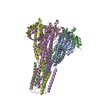 8ts1MC 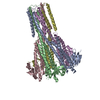 8ts2C 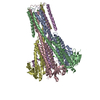 8ts3C M: atomic model generated by this map C: citing same article ( |
|---|---|
| Similar structure data | Similarity search - Function & homology  F&H Search F&H Search |
- Links
Links
| EMDB pages |  EMDB (EBI/PDBe) / EMDB (EBI/PDBe) /  EMDataResource EMDataResource |
|---|---|
| Related items in Molecule of the Month |
- Map
Map
| File |  Download / File: emd_41587.map.gz / Format: CCP4 / Size: 52.7 MB / Type: IMAGE STORED AS FLOATING POINT NUMBER (4 BYTES) Download / File: emd_41587.map.gz / Format: CCP4 / Size: 52.7 MB / Type: IMAGE STORED AS FLOATING POINT NUMBER (4 BYTES) | ||||||||||||||||||||||||||||||||||||
|---|---|---|---|---|---|---|---|---|---|---|---|---|---|---|---|---|---|---|---|---|---|---|---|---|---|---|---|---|---|---|---|---|---|---|---|---|---|
| Projections & slices | Image control
Images are generated by Spider. | ||||||||||||||||||||||||||||||||||||
| Voxel size | X=Y=Z: 1.2 Å | ||||||||||||||||||||||||||||||||||||
| Density |
| ||||||||||||||||||||||||||||||||||||
| Symmetry | Space group: 1 | ||||||||||||||||||||||||||||||||||||
| Details | EMDB XML:
|
-Supplemental data
-Additional map: #1
| File | emd_41587_additional_1.map | ||||||||||||
|---|---|---|---|---|---|---|---|---|---|---|---|---|---|
| Projections & Slices |
| ||||||||||||
| Density Histograms |
-Half map: #2
| File | emd_41587_half_map_1.map | ||||||||||||
|---|---|---|---|---|---|---|---|---|---|---|---|---|---|
| Projections & Slices |
| ||||||||||||
| Density Histograms |
-Half map: #1
| File | emd_41587_half_map_2.map | ||||||||||||
|---|---|---|---|---|---|---|---|---|---|---|---|---|---|
| Projections & Slices |
| ||||||||||||
| Density Histograms |
- Sample components
Sample components
-Entire : hMRS2-BRIL with Mg2+
| Entire | Name: hMRS2-BRIL with Mg2+ |
|---|---|
| Components |
|
-Supramolecule #1: hMRS2-BRIL with Mg2+
| Supramolecule | Name: hMRS2-BRIL with Mg2+ / type: complex / ID: 1 / Parent: 0 / Macromolecule list: #1 |
|---|---|
| Source (natural) | Organism:  Homo sapiens (human) Homo sapiens (human) |
-Macromolecule #1: Magnesium transporter MRS2 homolog, mitochondrial, Soluble cytoch...
| Macromolecule | Name: Magnesium transporter MRS2 homolog, mitochondrial, Soluble cytochrome b562 fusion protein type: protein_or_peptide / ID: 1 / Number of copies: 5 / Enantiomer: LEVO |
|---|---|
| Source (natural) | Organism:  |
| Molecular weight | Theoretical: 55.471691 KDa |
| Recombinant expression | Organism:  Komagataella pastoris (fungus) Komagataella pastoris (fungus) |
| Sequence | String: MVAGEVHRFR TSDVSQATLA SVAPVFTVTK FDKQGNVTSF ERKKTELYQE LGLQARDLRF QHVMSITVRN NRIIMRMEYL KAVITPECL LILDYRNLNL EQWLFRELPS QLSGEGQLVT YPLPFEFRAI EALLQYWINT LQGKLSILQP LILETLDALV D PKHSSVDR ...String: MVAGEVHRFR TSDVSQATLA SVAPVFTVTK FDKQGNVTSF ERKKTELYQE LGLQARDLRF QHVMSITVRN NRIIMRMEYL KAVITPECL LILDYRNLNL EQWLFRELPS QLSGEGQLVT YPLPFEFRAI EALLQYWINT LQGKLSILQP LILETLDALV D PKHSSVDR SKLHILLQNG KSLSELETDI KIFKESILEI LDEEELLEEL CVSKWSDPQV FEKSSAGIDH AEEMELLLEN YY RLADDLS NAARELRVLI DDSQSIIFIN LDSHRNVMMR LNLQLTMGTF SLSLFGLMGV AFGMNLESSL EEDHRIFWLI TGI MFMGSG LIWRRLLSFL GRQLEAPLPP MMASLPKKTL LADRSMELKN SLRLDADLED NWETLNDNLK VIEKADNAAQ VKDA LTKMR AAALDAQKAT PPKLEDKSPD SPEMKDFRHG FDILVGQIDD ALKLANEGKV KEAQAAAEQL KTTRNAYIQK YLSNS LEVL FQ UniProtKB: Magnesium transporter MRS2 homolog, mitochondrial, Soluble cytochrome b562 |
-Macromolecule #2: MAGNESIUM ION
| Macromolecule | Name: MAGNESIUM ION / type: ligand / ID: 2 / Number of copies: 7 / Formula: MG |
|---|---|
| Molecular weight | Theoretical: 24.305 Da |
-Experimental details
-Structure determination
| Method | cryo EM |
|---|---|
 Processing Processing | single particle reconstruction |
| Aggregation state | particle |
- Sample preparation
Sample preparation
| Buffer | pH: 8 Component:
Details: 20 mM Tris pH 8.0, 150 mM NaCl, 40 mM MgCl2 and 0.04 mM GDN | |||||||||||||||
|---|---|---|---|---|---|---|---|---|---|---|---|---|---|---|---|---|
| Vitrification | Cryogen name: ETHANE |
- Electron microscopy
Electron microscopy
| Microscope | TFS GLACIOS |
|---|---|
| Image recording | Film or detector model: FEI FALCON IV (4k x 4k) / Number real images: 2631 / Average electron dose: 41.0 e/Å2 |
| Electron beam | Acceleration voltage: 200 kV / Electron source:  FIELD EMISSION GUN FIELD EMISSION GUN |
| Electron optics | Illumination mode: FLOOD BEAM / Imaging mode: BRIGHT FIELD / Nominal defocus max: 2.4 µm / Nominal defocus min: 1.0 µm / Nominal magnification: 120000 |
 Movie
Movie Controller
Controller



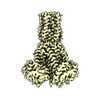









 Z (Sec.)
Z (Sec.) Y (Row.)
Y (Row.) X (Col.)
X (Col.)









